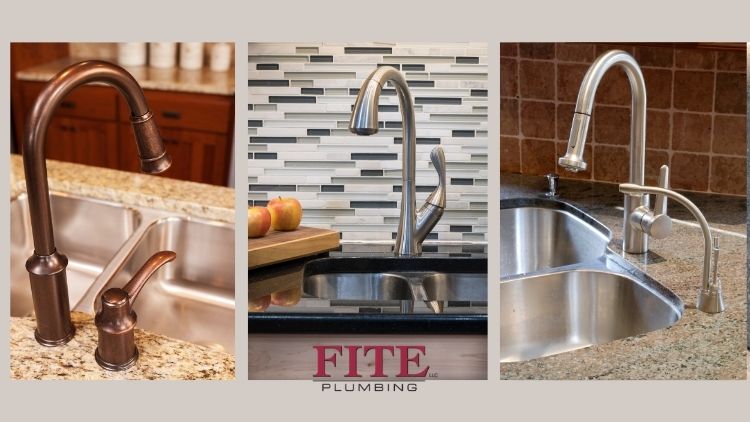If you intend to make your kitchen really functional, you should carefully consider all options in choosing the best kitchen faucet and sink. This applies to style, size, material, and more. Designers have come up with many types of popular sinks for the kitchen. Here are some practical tips on choosing a sink for the kitchen from your pals at Fite Plumbing.
How User-Friendly Is Your Kitchen Faucet and Sink?
Washing dishes is an inevitable chore that you perform every day or even several times a day. Even if you use a dishwashing machine, dishes likely stack up in the sink from time to time. Your mood may even depend on having a tidy and neat looking kitchen. That’s why it’s so important to choose a kitchen faucet and sink that’s convenient for you and your family.
Here are some things to consider:
- Do you need a large sink?
- Is it comfortable to work in and around?
- Does it fit organically with the design of your kitchen?
- Is it too loud, too deep, or too wide?
- Is your water supply designed for connecting the type of kitchen faucet or sink you prefer?
- Can it be placed far enough away from your wall or backsplash?
Selecting the Right Material for Your Home
You may not think that your kitchen faucet and sink material is an important choice, but you might be surprised.
Stainless Steel
The most popular material for making sinks is stainless steel. However, it’s important to note that manufacturers use different brands, not all of which are suitable for constant contact with water and detergents. Unfortunately, inferior quality steel is usually only recognized after corrosion stains appear on the basin’s surface.
Stainless steel surfaces are highly polished, matte, or have a physical vapor deposition (PVD) coating (also called thin-film coating). When selecting a stainless steel kitchen faucet or sink, pay attention to the brand. Well-known manufacturers are typically a safe choice. High-quality steel should contain at least 18% chromium and 10% nickel. This is the only way to guarantee its long life.
Additionally, before deciding which stainless steel sink is best for you, pay attention to the metal’s thickness. Don’t buy anything with a thickness of less than 0.5 mm. A thin sink basin may experience damage from kitchen utensils, pots, pans, and other solid objects. High-quality sinks are made with a thickness of up to 1.2 mm.
Artificial Stone
Sinks made from artificial stone are very trendy right now and are even as popular as stainless steel faucets and sinks. Artificial stone is a mixture of natural raw materials with polymeric binders. Marble or granite chips or quartz agglomerate are used as fillers. After solidification, the mixture is characterized by high strength, smooth surface, and the ability to retain its shape under mechanical and thermal influences.
Basically, artificial stone looks great and is and durable for both kitchens and bathrooms. This contemporary option is popular because you can choose from a wide range of colors. You can choose either a complete imitation of natural minerals or completely original colors and textures that cannot be found in nature. Countertops are also often made of polymer-mineral composite materials, so choosing the right faucet, sink, and countertop will give you a lovely combination for a beautiful kitchen.
Stone washbasins are almost noiseless, are not subject to corrosion, and are not damaged by detergents and organic solvents. Their mechanical strength and temperature resistance are also exceptionally high.
Ceramic
Ceramic sinks are also characterized by similar properties, although they are a bit rarer. There are much fewer color options, which can render ceramic kitchen faucets and sinks significantly inferior to artificial stones. Plus, they are less durable, heavier, and more difficult to install.
Cast Iron
Cast iron sinks are made by casting and are covered with a relatively thick and durable layer of porcelain enamel of different colors. In farmhouse, country, or vintage kitchen designs, white and bluish cast iron products are in demand because of their attractive appearance and practicality. Some cast iron sinks can even be considered works of art.
Cast iron sinks are characterized by their strength, high heat capacity, and high weight. Enamel is susceptible to sudden changes in temperature and can easily be damaged from solid objects or falling metal tools or utensils. This can crack not only the enamel but also the whole sink body.
Enamel is not inferior to stainless steel because of the ease of its surface maintenance, but it is more sensitive to abrasives. This just means that it’s better to wash cast iron kitchen faucets and sinks with soft sponges and a cloth.
Kitchen Faucets and Sinks Made From Other Materials
In addition to stainless steel, artificial stone, and cast iron, sinks can also be made from other materials:
- Glass
- Natural stone
- Copper
- Bronzes
- Polymers
There are even wooden sinks. As a rule, however, all sinks made from non-standard materials are individual products made only for a specific interior. They are expensive, are highly decorative but have limited functionality, and are not widely used.
Before Choosing Your Next Kitchen Sink
Keep in mind these queries when you begin your quest to find the right kitchen faucet and sink for your home.
- Which material works best for your family?
- What kind of design makes sense for your house?
- Do you want a faucet with a high or low spout?
- Have you considered a pull-out hose?
- Do you want a high-pressure or low-pressure valve?
- What extra functions must your sink and faucet perform?
If this seems like too much information, we can help. Call the experts at Fite Plumbing today at 317-271-5400. We’re your leading Indianapolis plumber serving Plainfield, Avon, Brownsburg, Mooresville, Greenwood, & surrounding Central Indiana areas
Are you on Facebook? We are, too. Let’s be friends!


